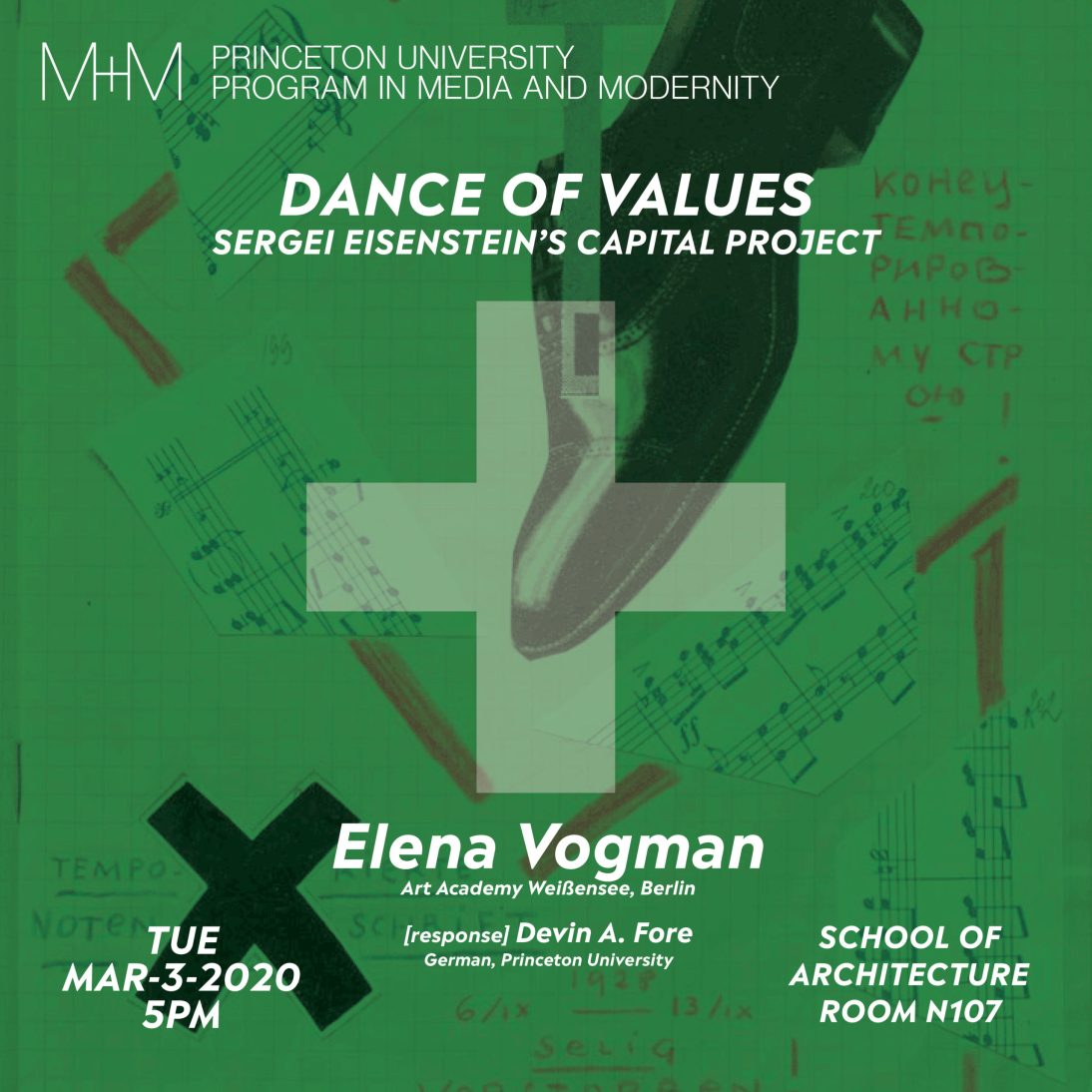Sprache
Typ
- Buch (6)
- Wissenschaftlicher Artikel (2)
- Interview (0)
- Video (0)
- Audio (0)
- Veranstaltung (0)
- Autoreninfo (0)
Zugang
Format
Kategorien
Zeitlich
Geographisch
Nutzerkonto
M+M Program in Media and Modernity: Elena Vogman, “Dance of Values”
03.03.2020, 17:00
Princeton University – School of Architecture – Room N107, 08544 Princeton, NJ

M+M Program in Media and Modernity presents:
Elena Vogman
“Dance of Values: Sergei Eisenstein’s Capital Project”
[response by Devin A. Fore]
Sergei Eisenstein’s planned film adaptation of Karl Marx’s Capital stands as one of the most enigmatic projects in the history of cinema. Though never realized, it has haunted the imagination of many filmmakers, historians, and philosophers to the present day. A recent look into Eisenstein’s archive revealed the full scope of his plans: between October 1927 and September 1928, he gradually transformed his working diaries into an editing board. This “visual instruction in the dialectical method,” as Eisenstein himself called his project, comprises over 500 pages of notes, drawings, press clippings, expression diagrams, plans for articles, negatives from October, theoretical reflections and extensive quotations. What can be seen and read is not a film but a series of variations on the themes of economy and capitalist exploitation.
Elena Vogman’s recent book Dance of Values: Sergei Eisenstein’s Capital Project explores the internal formal necessity underlying the director’s choices, arguing that Capital’s visual complexity as well as its epistemic efficacy resides precisely within the state of its material: the dance of heterogeneous themes and disparate fragments, a non-linear, provisory, and non-articulated flow. In this way Eisenstein’s montage sequences produce a kind of surplus value entirely their own: a semiotic excess, which stirs the materials and represented bodies into a dance analogous to Marx’s “dance” of “petrified conditions.” It is in this polymorphic and “diffuse” language—associated with the stream of consciousness of Joyce's Ulysses—that Eisenstein saw the strongest critical and affective potential for the future cinema.
With Elena Vogamn and Devin A. Fore, Professor of German in the German Department at Princeton University.
Elena Vogman
ist Autorin, Literatur- und Medienwissenschaftlerin und Kuratorin. Sie promovierte in 2016 über »Sinnliches Denken. Eisensteins exzentrische Methode« und war seitdem Postdoc im Forschungsprojekt »Rhythmus und Projektion« an der Freien Universität sowie Fellow am IKKM an der Universität Weimar. Sie lehrt Geschichte und Theorie der Medien an der Kunsthochschule Berlin Weißensee und arbeitet an einem Forschungsprojekt zu »Madness, Media, Milieus. Reconfiguring the Humanities in Postwar Europe«. Im Fokus ihrer Forschung stehen Formen des visuellen Denkens, Anthropologien des Rhythmus, Montagepraxis sowie Medien und Milieus in der Praxis der Institutionellen Psychotherapie. Gemeinsam mit Marie Rebecchi und Till Gathmann kuratierte sie die Ausstellung »Sergei Eisenstein: The Anthropology of Rhythm« bei Nomas Foundation in Rom.